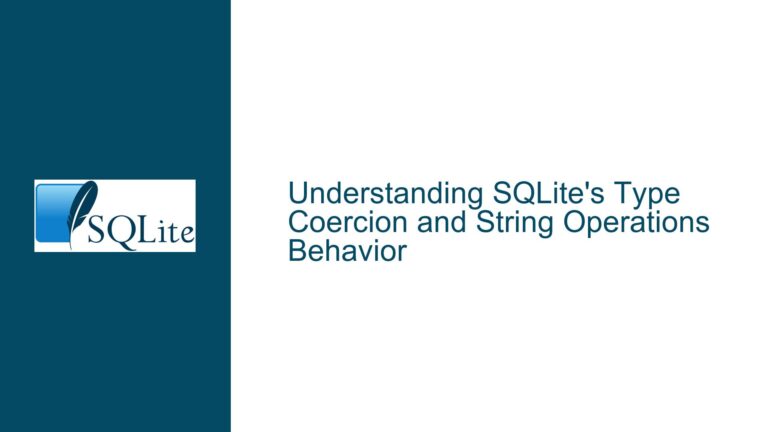Complex SQL Queries with NOT EXISTS and EXCEPT Clauses
Issue Overview: Decoding SQL Queries with NOT EXISTS and EXCEPT
The core issue revolves around understanding two SQL queries that utilize the NOT EXISTS and EXCEPT clauses. These queries are designed to retrieve specific student records based on certain conditions related to their grades and course sections. The first query aims to fetch students who have never received a grade other than ‘A’, while the second query retrieves students who have enrolled in all sections taught by a specific instructor during certain years.
The first query is structured as follows:
SELECT StudentNo, Name, Department
FROM Student S
WHERE NOT EXISTS (
SELECT StudentNo
FROM GradeReport
WHERE StudentNo = S.StudentNo AND Grade != 'A'
);
This query selects students from the Student table where there does not exist a record in the GradeReport table for that student with a grade other than ‘A’. In other words, it filters out students who have ever received a grade lower than ‘A’.
The second query is more complex:
SELECT StudentNo, Name, Department
FROM Student S
WHERE NOT EXISTS (
(SELECT SectionNo
FROM Section
WHERE Instructor = 'Clark' AND (Year = 2018 OR Year = 2019))
EXCEPT
(SELECT SectionNo
FROM GradeReport G
WHERE G.StudentNo = S.StudentNo)
);
This query selects students from the Student table where there does not exist a section taught by the instructor ‘Clark’ during the years 2018 or 2019 that the student has not enrolled in. Essentially, it retrieves students who have enrolled in all sections taught by ‘Clark’ during those years.
Possible Causes: Misunderstanding SQL Logic and Set Operations
The confusion likely stems from a lack of understanding of how the NOT EXISTS and EXCEPT clauses operate in SQL. The NOT EXISTS clause is used to check for the absence of certain records in a subquery. If the subquery returns no rows, the NOT EXISTS condition is satisfied, and the outer query includes that row in its result set. On the other hand, the EXCEPT clause is used to return all rows from the first query that are not present in the second query. It essentially performs a set difference operation.
In the first query, the NOT EXISTS clause ensures that only students who have never received a grade other than ‘A’ are selected. This is achieved by checking for the absence of any record in the GradeReport table where the student’s grade is not ‘A’. If such a record exists, the student is excluded from the result set.
In the second query, the NOT EXISTS clause is combined with the EXCEPT clause to ensure that only students who have enrolled in all sections taught by ‘Clark’ during 2018 or 2019 are selected. The subquery within the NOT EXISTS clause first retrieves all sections taught by ‘Clark’ during those years. The EXCEPT clause then removes any sections that the student has enrolled in, as indicated by the GradeReport table. If the result of this operation is an empty set (i.e., the student has enrolled in all sections), the NOT EXISTS condition is satisfied, and the student is included in the result set.
Troubleshooting Steps, Solutions & Fixes: Breaking Down the Queries
To fully understand and troubleshoot these queries, it is essential to break them down into smaller, more manageable parts. This approach allows for a clearer understanding of the logic and helps identify any potential issues or misunderstandings.
Step 1: Understanding the NOT EXISTS Clause
The NOT EXISTS clause is a powerful tool in SQL that allows you to filter rows based on the absence of certain records in a subquery. In the context of the first query, the NOT EXISTS clause is used to ensure that only students who have never received a grade other than ‘A’ are selected.
To better understand how this works, consider the following simplified version of the first query:
SELECT StudentNo, Name, Department
FROM Student S
WHERE NOT EXISTS (
SELECT 1
FROM GradeReport
WHERE StudentNo = S.StudentNo AND Grade != 'A'
);
In this query, the subquery checks for the existence of any record in the GradeReport table where the student’s grade is not ‘A’. If such a record exists, the NOT EXISTS condition is not satisfied, and the student is excluded from the result set. If no such record exists, the NOT EXISTS condition is satisfied, and the student is included in the result set.
Step 2: Understanding the EXCEPT Clause
The EXCEPT clause is used to return all rows from the first query that are not present in the second query. It essentially performs a set difference operation. In the context of the second query, the EXCEPT clause is used to remove any sections that the student has enrolled in from the list of sections taught by ‘Clark’ during 2018 or 2019.
To better understand how this works, consider the following simplified version of the second query:
SELECT SectionNo
FROM Section
WHERE Instructor = 'Clark' AND (Year = 2018 OR Year = 2019)
EXCEPT
SELECT SectionNo
FROM GradeReport G
WHERE G.StudentNo = S.StudentNo;
In this query, the first subquery retrieves all sections taught by ‘Clark’ during 2018 or 2019. The second subquery retrieves all sections that the student has enrolled in, as indicated by the GradeReport table. The EXCEPT clause then removes any sections that the student has enrolled in from the list of sections taught by ‘Clark’. If the result of this operation is an empty set (i.e., the student has enrolled in all sections), the NOT EXISTS condition is satisfied, and the student is included in the result set.
Step 3: Combining NOT EXISTS and EXCEPT
The second query combines the NOT EXISTS and EXCEPT clauses to ensure that only students who have enrolled in all sections taught by ‘Clark’ during 2018 or 2019 are selected. This is achieved by first retrieving all sections taught by ‘Clark’ during those years and then removing any sections that the student has enrolled in. If the result of this operation is an empty set, the NOT EXISTS condition is satisfied, and the student is included in the result set.
To better understand how this works, consider the following breakdown of the second query:
SELECT StudentNo, Name, Department
FROM Student S
WHERE NOT EXISTS (
(SELECT SectionNo
FROM Section
WHERE Instructor = 'Clark' AND (Year = 2018 OR Year = 2019))
EXCEPT
(SELECT SectionNo
FROM GradeReport G
WHERE G.StudentNo = S.StudentNo)
);
In this query, the subquery within the NOT EXISTS clause first retrieves all sections taught by ‘Clark’ during 2018 or 2019. The EXCEPT clause then removes any sections that the student has enrolled in, as indicated by the GradeReport table. If the result of this operation is an empty set (i.e., the student has enrolled in all sections), the NOT EXISTS condition is satisfied, and the student is included in the result set.
Step 4: Verifying the Results
To ensure that the queries are working as intended, it is important to verify the results. This can be done by running the queries against a sample dataset and checking the output. For example, you can create a sample Student table, GradeReport table, and Section table with a few records and run the queries to see if they return the expected results.
Here is an example of how you can create a sample dataset:
CREATE TABLE Student (
StudentNo INTEGER PRIMARY KEY,
Name TEXT,
Department TEXT
);
CREATE TABLE GradeReport (
StudentNo INTEGER,
SectionNo INTEGER,
Grade TEXT,
FOREIGN KEY (StudentNo) REFERENCES Student(StudentNo)
);
CREATE TABLE Section (
SectionNo INTEGER PRIMARY KEY,
Instructor TEXT,
Year INTEGER
);
INSERT INTO Student (StudentNo, Name, Department) VALUES (1, 'Alice', 'Computer Science');
INSERT INTO Student (StudentNo, Name, Department) VALUES (2, 'Bob', 'Mathematics');
INSERT INTO Student (StudentNo, Name, Department) VALUES (3, 'Charlie', 'Physics');
INSERT INTO Section (SectionNo, Instructor, Year) VALUES (101, 'Clark', 2018);
INSERT INTO Section (SectionNo, Instructor, Year) VALUES (102, 'Clark', 2019);
INSERT INTO Section (SectionNo, Instructor, Year) VALUES (103, 'Smith', 2018);
INSERT INTO GradeReport (StudentNo, SectionNo, Grade) VALUES (1, 101, 'A');
INSERT INTO GradeReport (StudentNo, SectionNo, Grade) VALUES (1, 102, 'A');
INSERT INTO GradeReport (StudentNo, SectionNo, Grade) VALUES (2, 101, 'B');
INSERT INTO GradeReport (StudentNo, SectionNo, Grade) VALUES (2, 102, 'A');
INSERT INTO GradeReport (StudentNo, SectionNo, Grade) VALUES (3, 101, 'A');
INSERT INTO GradeReport (StudentNo, SectionNo, Grade) VALUES (3, 102, 'B');
With this sample dataset, you can run the queries and verify the results. For example, the first query should return only Alice, as she is the only student who has never received a grade other than ‘A’. The second query should return Alice and Bob, as they are the only students who have enrolled in all sections taught by ‘Clark’ during 2018 or 2019.
Step 5: Optimizing the Queries
Once you have verified that the queries are working as intended, you can consider optimizing them for better performance. This can be done by ensuring that the tables are properly indexed and that the queries are written in a way that minimizes the number of rows scanned.
For example, you can create indexes on the StudentNo column in the GradeReport table and the SectionNo column in the Section table to speed up the queries:
CREATE INDEX idx_grade_report_studentno ON GradeReport (StudentNo);
CREATE INDEX idx_section_sectionno ON Section (SectionNo);
Additionally, you can rewrite the queries to use JOIN operations instead of subqueries, which can sometimes be more efficient. For example, the first query can be rewritten as follows:
SELECT S.StudentNo, S.Name, S.Department
FROM Student S
LEFT JOIN GradeReport G ON S.StudentNo = G.StudentNo AND G.Grade != 'A'
WHERE G.StudentNo IS NULL;
This query uses a LEFT JOIN to join the Student table with the GradeReport table on the condition that the student’s grade is not ‘A’. The WHERE clause then filters out any rows where a matching record in the GradeReport table exists, effectively achieving the same result as the original query.
Similarly, the second query can be rewritten using JOIN operations:
SELECT S.StudentNo, S.Name, S.Department
FROM Student S
WHERE NOT EXISTS (
SELECT 1
FROM Section Sec
LEFT JOIN GradeReport G ON Sec.SectionNo = G.SectionNo AND G.StudentNo = S.StudentNo
WHERE Sec.Instructor = 'Clark' AND (Sec.Year = 2018 OR Sec.Year = 2019)
AND G.SectionNo IS NULL
);
This query uses a LEFT JOIN to join the Section table with the GradeReport table on the condition that the student has enrolled in the section. The WHERE clause then filters out any sections that the student has not enrolled in, effectively achieving the same result as the original query.
Step 6: Handling Edge Cases
Finally, it is important to consider edge cases when working with these queries. For example, what happens if a student has not enrolled in any sections? Or if a section has no students enrolled? These edge cases should be handled appropriately to ensure that the queries return the correct results.
For example, if a student has not enrolled in any sections, the second query should still return that student if they have enrolled in all sections taught by ‘Clark’ during 2018 or 2019. However, if a section has no students enrolled, the query should still return the correct results.
To handle these edge cases, you can modify the queries to include additional conditions. For example, you can modify the second query to include a check for students who have not enrolled in any sections:
SELECT StudentNo, Name, Department
FROM Student S
WHERE NOT EXISTS (
(SELECT SectionNo
FROM Section
WHERE Instructor = 'Clark' AND (Year = 2018 OR Year = 2019))
EXCEPT
(SELECT SectionNo
FROM GradeReport G
WHERE G.StudentNo = S.StudentNo)
)
OR NOT EXISTS (
SELECT SectionNo
FROM GradeReport G
WHERE G.StudentNo = S.StudentNo
);
This query includes an additional OR condition to check if the student has not enrolled in any sections. If the student has not enrolled in any sections, they are included in the result set.
Similarly, you can modify the first query to handle edge cases where a student has not received any grades:
SELECT StudentNo, Name, Department
FROM Student S
WHERE NOT EXISTS (
SELECT StudentNo
FROM GradeReport
WHERE StudentNo = S.StudentNo AND Grade != 'A'
)
OR NOT EXISTS (
SELECT StudentNo
FROM GradeReport
WHERE StudentNo = S.StudentNo
);
This query includes an additional OR condition to check if the student has not received any grades. If the student has not received any grades, they are included in the result set.
Conclusion
Understanding complex SQL queries with NOT EXISTS and EXCEPT clauses requires a solid grasp of SQL logic and set operations. By breaking down the queries into smaller parts, verifying the results, optimizing the queries, and handling edge cases, you can ensure that your queries are both accurate and efficient. With practice and experience, you will become more comfortable with these advanced SQL techniques and be able to apply them effectively in your own projects.






